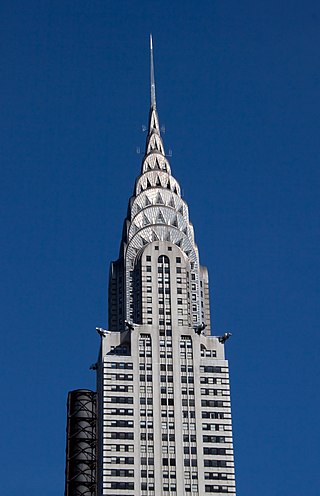
Art Deco, short for the French Arts Décoratifs, is a style of visual arts, architecture, and product design, that first appeared in Paris in the 1910s, and flourished in the United States and Europe during the 1920s to early 1930s. Through styling and design of the exterior and interior of anything from large structures to small objects, including how people look, Art Deco has influenced bridges, buildings, ships, ocean liners, trains, cars, trucks, buses, furniture, and everyday objects including radios and vacuum cleaners.

Art Nouveau is an international style of art, architecture, and applied art, especially the decorative arts. It was often inspired by natural forms such as the sinuous curves of plants and flowers. Other characteristics of Art Nouveau were a sense of dynamism and movement, often given by asymmetry or whiplash lines, and the use of modern materials, particularly iron, glass, ceramics and later concrete, to create unusual forms and larger open spaces. It was popular between 1890 and 1910 during the Belle Époque period, and was a reaction against the academicism, eclecticism and historicism of 19th century architecture and decorative art.

Louis Comfort Tiffany was an American artist and designer who worked in the decorative arts and is best known for his work in stained glass. He is associated with the art nouveau and aesthetic art movements. He was affiliated with a prestigious collaborative of designers known as the Associated Artists, which included Lockwood de Forest, Candace Wheeler, and Samuel Colman. Tiffany designed stained glass windows and lamps, glass mosaics, blown glass, ceramics, jewellery, enamels, and metalwork. He was the first design director at his family company, Tiffany & Co., founded by his father Charles Lewis Tiffany.
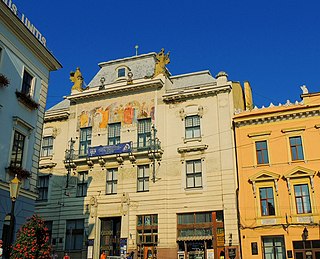
Chernivtsi is a city in southwestern Ukraine on the upper course of the Prut River. Formerly the capital of the historic region of Bukovina, which is now divided between Romania and Ukraine, Chernivtsi serves as the administrative center for the Chernivtsi Raion, the Chernivtsi urban hromada, and the oblast itself. In 2022, the Chernivtsi population, by estimate, is 264,298, and the latest census in 2001 was 240,600.
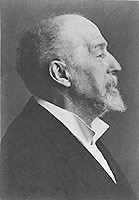
Otto Koloman Wagner was an Austrian architect, furniture designer and urban planner. He was a leading member of the Vienna Secession movement of architecture, founded in 1897, and the broader Art Nouveau movement. Many of his works are found in his native city of Vienna, and illustrate the rapid evolution of architecture during the period. His early works were inspired by classical architecture. By mid-1890s, he had already designed several buildings in what became known as the Vienna Secession style. Beginning in 1898, with his designs of Vienna Metro stations, his style became floral and Art Nouveau, with decoration by Koloman Moser. His later works, 1906 until his death in 1918, had geometric forms and minimal ornament, clearly expressing their function. They are considered predecessors to modern architecture.

The Vienna Secession is an art movement, closely related to Art Nouveau, that was formed in 1897 by a group of Austrian painters, graphic artists, sculptors and architects, including Josef Hoffman, Koloman Moser, Otto Wagner and Gustav Klimt. They resigned from the Association of Austrian Artists in protest against its support for more traditional artistic styles. Their most influential architectural work was the Secession exhibitions hall designed by Joseph Maria Olbrich as a venue for expositions of the group. Their official magazine was called Ver Sacrum, which published highly stylised and influential works of graphic art. In 1905 the group itself split, when some of the most prominent members, including Klimt, Wagner, and Hoffmann, resigned in a dispute over priorities, but it continued to function, and still functions today, from its headquarters in the Secession Building. In its current form, the Secession exhibition gallery is independently led and managed by artists.

The Chicago Cultural Center, opened in 1897, is a Chicago Landmark building operated by Chicago's Department of Cultural Affairs and Special Events. The Cultural Center houses the city's official reception venue, where the Mayor of Chicago has welcomed presidents, royalty, diplomats, and community leaders. It is located in the Loop, across Michigan Avenue from Millennium Park.

The Mohatta Palace is a museum located in Karachi, Sindh, Pakistan. Designed by Ahmed Hussain Agha, the palace was built in 1927 in the posh seaside locale of Clifton as the summer home of Shivratan Mohatta, a Hindu Marwari businessman from what is now the modern-day Indian state of Rajasthan. The palace was built in the tradition of stone palaces of Rajasthan, using pink Jodhpur stone in combination with the local yellow stone from nearby Gizri. Mohatta could enjoy this building for only about two decades before the partition of India, after which he left Karachi for the new state of India.

The Villa Majorelle is a house located at 1 rue Louis-Majorielle in the city of Nancy, France, which was the home and studio of the furniture designer Louis Majorelle. It was designed and built by the architect Henri Sauvage in 1901-1902. The villa is one of the first and most influential examples of the Art Nouveau architectural style in France. It served as a showcase for Majorelle's furniture and the work of other noted decorative artists of the period, including ceramist Alexandre Bigot and stained glass artist Jacques Gruber. It is now owned by the city of Nancy, and is open to the public certain days for tours by reservation.

The Cooperative Business Bank Building is a building designed in 1921 by architect Ivan Vurnik and his wife Helena Vurnik in the so-called Slovene "National Style" using decorative ornaments in the colors of Slovene tricolor and was inspired by the Vienna Secession style of architecture. It was commissioned by the Cooperative Business Bank, a local credit institution. It is located on Miklosich Street, Ljubljana, capital city of Slovenia, and has been called "the most beautiful building" in Ljubljana.
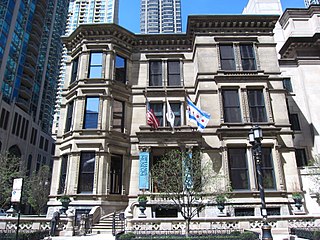
The Richard H. Driehaus Museum is a museum located at 40 East Erie Street on the Near North Side in Chicago, Illinois, near the Magnificent Mile. The museum is housed within the historic Samuel M. Nickerson House, the 1883 residence of a wealthy Chicago banker. Although the mansion has been restored, the Driehaus Museum does not re-create the Nickerson period but rather broadly interprets and displays the prevailing design, architecture, and decorating tastes of Gilded Age America and the art nouveau era in permanent and special exhibitions.

Casa Bonaventura Ferrer is a building located at number 113 of Passeig de Gràcia in Barcelona, Catalonia, Spain, and rear facade at number 6 in the Riera de Sant Miquel. It is a project of the architect Pere Falqués i Urpí following a Modernisme or Art Nouveau style, being erected in 1906.

The Quinta Gameros is a mansion in Chihuahua, Chihuahua. The building is an Historic National Monument of Mexico. Quinta Gameros currently houses the Centro Cultural Universitario Quinta Gameros, a regional museum of Mexico.

The Art Nouveau movement of architecture and design first appeared in Brussels, Belgium, in the early 1890s, and quickly spread to France and to the rest of Europe. It began as a reaction against the formal vocabulary of European academic art, eclecticism and historicism of the 19th century, and was based upon an innovative use of new materials, such as iron and glass, to open larger interior spaces and provide maximum light; curving lines such as the whiplash line; and other designs inspired by plants and other natural forms.

Jana Zamoyskiego Street is located in downtown district, in Bydgoszcz, Poland. Most of its buildings display Eclectic, Art Nouveau or early modernist architectural styles. One of them is registered on the Kuyavian-Pomeranian Voivodeship heritage list.

The Gorky Museum is an architectural landmark of the "Moderne" style, the Russian term for Art Nouveau. It was built in Moscow in 1900–02 by the architect Fyodor Schechtel. It is also known as the Ryabouchinsky House, for the young Russian industrialist and art collector who built it. After the Russian Revolution in 1917, the Ryabouchinsky family emigrated to France. In 1931 the Soviet government offered the house to the writer Maxim Gorky and his family. It was his home until his death in 1936. The widow of Gorky's son continued to live in the house until her death in 1965. It then became the Gorky Museum, dedicated to his life and work. It is located in the historic center of Moscow, at 6 Malaya Nikitskaya. Admission is free.

The whiplash or whiplash line is a motif of decorative art and design that was particularly popular in Art Nouveau. It is an asymmetrical, sinuous line, often in an ornamental S curve, usually inspired by natural forms such as plants and flowers, which suggests dynamism and movement. It took its name from a woven fabric panel called "Coup de Fouet" ("Whiplash") by the German artist Hermann Obrist (1895) which depicted the stems and roots of the cyclamen flower. The panel was later reproduced by the textile workshop of the Darmstadt Artists Colony.

Art Nouveau glass is fine glass in the Art Nouveau style. Typically the forms are undulating, sinuous and colorful art, usually inspired by natural forms. Pieces are generally larger than drinking glasses, and decorative rather than practical, other than for use as vases and lighting fittings; there is little tableware. Prominently makers, from the 1890s onwards, are in France René Lalique, Emile Gallé and the Daum brothers, the American Louis Comfort Tiffany, Christopher Dresser in Scotland and England, and Friedrich Zitzman, Karl Koepping and Max Ritter von Spaun in Germany. Art Nouveau glass included decorative objects, vases, lamps, and stained glass windows. It was usually made by hand, and was usually colored with metal oxides while in a molten state in a furnace.

The Hôtel Hannon is a historic town house in Brussels, Belgium. Constructed between 1903 and 1904, in Art Nouveau style, for the industrialist Édouard Hannon, it is the only house in that style designed by the architect Jules Brunfaut.
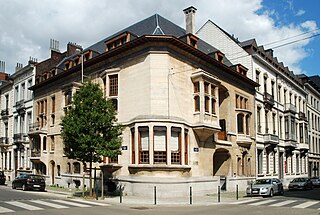
The Hôtel Otlet is a historic town house in Brussels, Belgium. It was designed by the architect Octave van Rysselberghe for the jurist, bibliographer and entrepreneur Paul Otlet, and built between 1894 and 1898, in Art Nouveau style. This work marks the still cautious insertion of Van Rysselberghe into that style.






















